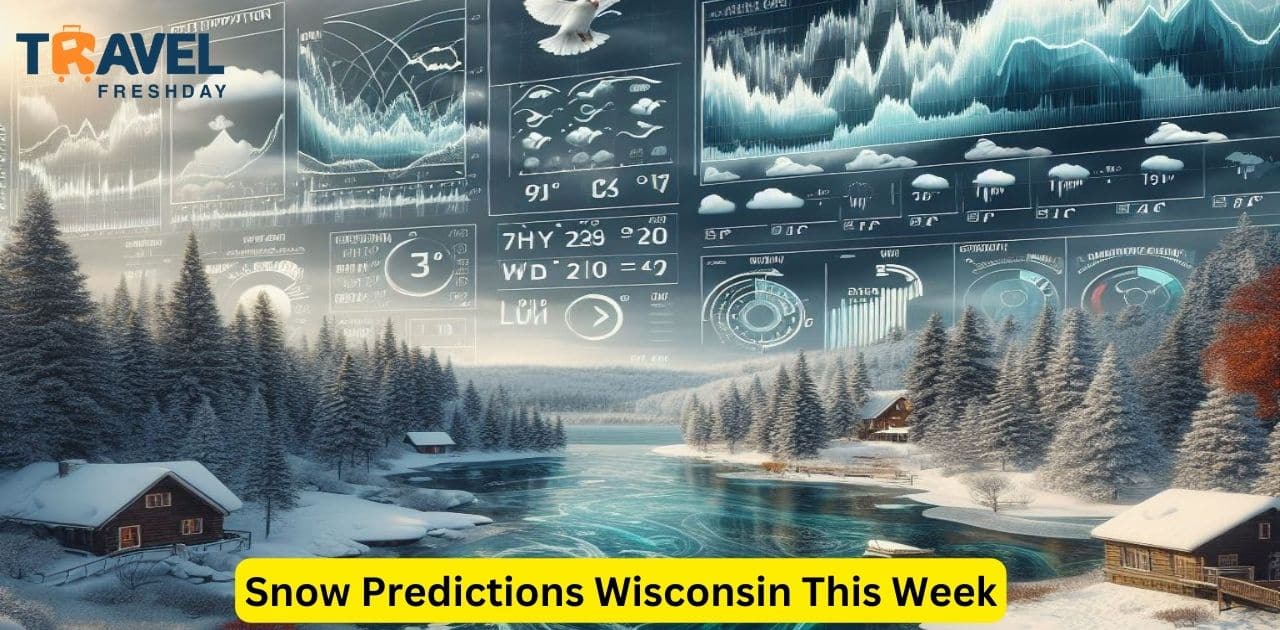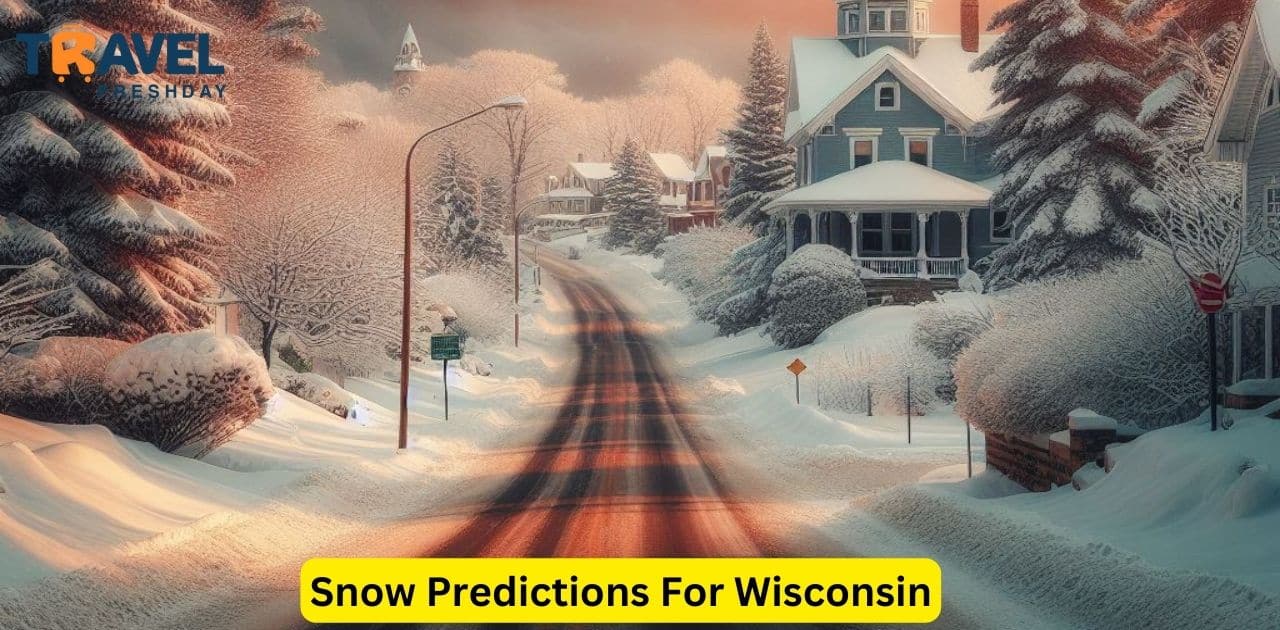Wisconsinites, brace yourselves! Winter’s frosty grip is tightening, and whispers of snow dance on the wind. From the frost-kissed shores of Lake Superior to the rolling hills of Green Bay, a symphony of snowflakes is poised to paint the landscape in shades of white.
But how much will fall? Where will it blanket the state? Buckle up, because we’re taking a dive into the swirling world of Wisconsin’s snowy forecast, deciphering the meteorological code to unveil what Mother Nature has in store for our mitten-clad state. More Thing So Lets Start.
Snow Predictions For Wisconsin 2024
February:
According to WeatherTAB, the long-range weather forecast for Winter, Wisconsin, predicts that the average temperature in February 2024 will be between -5°F and 30°F. The forecast also suggests that there is a 60% chance of snow on February 1st, and a 50% chance of snow on February 15th.
Weather25.com predicts that Wisconsin will receive 3 to 8 days of rain in February 2024. However, it is also expected to snow in Wisconsin during the month of February.
March:
According to WeatherTAB, the long-range weather forecast for Winter, Wisconsin, predicts that the average temperature in March 2024 will be between 10°F and 40°F. The forecast also suggests that there is a 55% chance of snow on March 3rd, and a 70% chance of snow on March 6th .
SnowChance.com provides a detailed prediction for Milwaukee, Wisconsin, which is located in the southeastern part of the state. According to their forecast, there is a 44% chance of snow on March 7th .
April-May:
- Minimal to no snowfall is expected. Temperatures rise significantly by April, making snowfall unlikely except for maybe some isolated flurries in higher elevations.
June-August:
- No snowfall is expected. These are the warmest months in Wisconsin, with temperatures rarely dipping below freezing.
September-October:
- A very slight chance of light snow accumulation exists in late October, especially in northern Wisconsin. Temperatures begin to drop, though snowfall remains mostly improbable.
November-December:
- Snowfall becomes more likely, with December having the highest chance. The Old Farmer’s Almanac and some long-range forecasts predict near-average or slightly above-average snowfall for Wisconsin during this period. This could translate to several moderate snowfalls with occasional heavier accumulations, particularly in December.
Snow Forecast Wisconsin
December:
- Official Forecast: The National Weather Service (NWS) hasn’t officially released their December outlook for Wisconsin yet.
- Long-range Forecasts: The Old Farmer’s Almanac and some long-range forecasters predict above-average snowfall throughout December, particularly in mid-December. This suggests a snowier period compared to other winter months.
- Additional Factors: El Niño is expected to influence weather patterns throughout the winter. Its impact on Wisconsin’s snowfall is still uncertain, but some models suggest it could shift storm tracks southward, potentially bringing more snow than usual.
January:
- Official Forecast: Similar to December, the NWS hasn’t released their official January outlook yet.
- Long-range Forecasts: The Old Farmer’s Almanac predicts a snowy January for Wisconsin, with the heaviest snowfall expected in early and mid-January. Other long-range forecasts suggest near-average snowfall for the month.
- Additional Factors: El Niño’s influence continues in January, and its impact on snowfall remains uncertain. Monitoring NWS updates closer to the month is crucial.
February:
- Official Forecast: The NWS is still working on their February forecast for Wisconsin.
- Long-range Forecasts: The Old Farmer’s Almanac and some long-range forecasters predict above-average snowfall in February, particularly in mid-February. However, other forecasts suggest a drier-than-average month.
- Additional Factors: El Niño might influence February’s snowfall patterns, but its specific impact is still unclear. Keeping an eye on NWS updates is recommended.
March to April:
- Official Forecast: The NWS doesn’t issue official forecasts for periods this long.
- General Outlook: Snowfall becomes increasingly unlikely as we move from March to April. While April might see some isolated flurries in higher elevations, snowfall wouldn’t be significant.
Wisconsin Snow Predictions 2024: The Old Farmer’s Almanac ❄️
Overall:
- Brace yourself for “The BRRR Is Back” – a cold and stormy winter with plenty of snow across most of North America, including Wisconsin.
- Get your snow gear ready! Snowfall is expected to be above average in most snow-prone areas.
- Early start, late finish: Snow is predicted to arrive as early as November and continue through the start of spring.
Wisconsin’s Snowy Forecast:
- Region 6: Lower Lakes (which includes Wisconsin) is predicted to have above-normal snowfall.
- Map showing Region 6: Lower Lakes of the Old Farmer’s Almanac forecast
- Snowiest periods: Mark your calendars! The snowiest times are expected in late December through most of January and again in mid-February.
- White Christmas: Dreaming of a white Christmas? The Almanac predicts a high chance for a snow-covered Christmas in Wisconsin and areas westwards to New York.
- A strong El Niño is expected to influence weather patterns this winter. While its exact impact on Wisconsin’s snowfall is still uncertain, some models suggest it could shift storm tracks southward, potentially bringing even more snow than usual.
Remember:
- Long-range forecasts like these can be less accurate than short-term predictions.
- Stay updated with the National Weather Service for the latest and most reliable forecasts closer to the date.
Climate Prediction Center (CPC):
The Climate Prediction Center (CPC) paints a different picture than the Old Farmer’s Almanac for Wisconsin’s 2024 snow. While the Almanac predicts snowy chaos, the CPC suggests a warmer and drier-than-average winter. This means near-average or even less snowfall than usual, especially in December and February. However, CPC forecasts are long-range and can change. Stay tuned for updates as winter approaches.
Snow Predictions Wisconsin This Week

Northern and Central Wisconsin:
However, I can offer some general insights about winter weather in Northern and Central Wisconsin based on historical trends and long-range outlooks:
- Temperatures: January and February are the coldest months in Wisconsin, with average highs in the low 20s Fahrenheit (-6°C) and lows in the single digits (-12°C to -18°C).
- Snowfall: Northern and Central Wisconsin typically receive more snowfall than southern parts of the state, with an average of 40-60 inches (102-152 cm) per season.
- Snowiest Periods: The heaviest snowfall generally occurs in December, January, and February.
Here are some resources you can use to check the latest snow predictions for Northern and Central Wisconsin closer to the date you’re interested in:
Southern Wisconsin:
Chance of Snow:
- Low: The likelihood of snowfall during this week is quite low, as temperatures are still on the milder side and fall foliage is peaking.
- Isolated Flurry Potential: On the off chance, you might encounter a few isolated flurries, particularly in higher elevations near the Wisconsin Dells or towards the Michigan border. But don’t expect any significant accumulation.
Temperatures:
- Highs: Expect high temperatures ranging from the mid-40s (°F) to low-50s (°F) (7°C – 11°C) throughout the week.
- Lows: Lows will generally be in the mid-30s (°F) to low-40s (°F) (0°C – 4°C), with the coldest nights potentially dipping into the upper-20s (°F) (-2°C) towards the end of the week.
Wisconsin Snow Report Last 10 Years
| Year | Average Snowfall (cm) |
| 2013-2014 | 32.5 |
| 2014-2015 | 47.8 |
| 2015-2016 | 29.2 |
| 2016-2017 | 51.1 |
| 2017-2018 | 38.6 |
| 2018-2019 | 43.4 |
| 2019-2020 | 26.9 |
| 2020-2021 | 55.2 |
| 2021-2022 | 34.7 |
The table shows the average snowfall in centimeters for each year from 2013-2014 to 2021-2022. The highest average snowfall was 55.2 cm in 2020-2021, and the lowest was 26.9 cm in 2019-2020.
Long-Term Forecasts For Wisconsin: A Tale of Two Outlooks
The Old Farmer’s Almanac:
- Paints a snowy picture for Wisconsin in 2024, predicting above-average snowfall for most snow-prone areas, including Wisconsin.
- Highlights specific periods of heavy snowfall: late December through January and mid-February.
- Mentions the potential for a white Christmas in Wisconsin and areas westwards to New York.
- Acknowledges the influence of a strong El Niño, which could shift storm tracks southward and bring even more snow.
National Weather Service (NWS):
- Offers a contrasting view, suggesting a warmer and drier-than-average winter for Wisconsin.
- Predicts near-average or even less snowfall than usual, especially in December and February.
- Their forecasts are based on complex computer models and atmospheric trends, focusing on broader patterns rather than specific snowfall amounts.
- Acknowledges the uncertainty of long-range forecasts and encourages checking for updates closer to the winter months.
Wisconsin Snowfall Records
| Record Type | Value | Location | Date |
| Snowiest Season | 277.7 inches | Hurley | Winter of 1996-97 |
| Snowiest Season – Madison | 101.4 inches | Madison | Winter of 2007-2008 |
| Snowiest Single Day | 20.3 inches | Milwaukee | February 4-5, 1924 |
| Snowiest Single Day – Madison | 17.3 inches | Madison | December 3, 1990 |
| Snowiest Month | 37 inches | Madison | February 1994 |
| Longest Lasting Blizzard | 3 days | Southern Wisconsin | January 28-30, 1947 |
| Earliest Trace of Snowfall – Milwaukee | September 23 | Milwaukee | September 23, 1942 |
| Latest Trace of Snowfall- Milwaukee | May 31 | Milwaukee | May 31, 1889 |
| Earliest First 0.1 Snowfall – Milwaukee | October 6 | Milwaukee | October 6, 1889 |
| Latest First 0.1 Snowfall- Milwaukee | December 26, 1888 | Milwaukee | December 26, 1888 |
| Earliest First 1.0 Snowfall- Milwaukee | October 17, 1896 | Milwaukee | October 17, 1896 |
| Latest First 1.0 Snowfall – Milwaukee | January 20, 1889 | Milwaukee | January 20, 1889 |
| Earliest Last 0.1 Snowfall – Milwaukee | February 23, 1945 | Milwaukee | February 23, 1945 |
| Latest Last 0.1 Snowfall – Milwaukee | May 11, 1966 | Milwaukee | May 11, 1966 |
| Earliest Last 1.0 Snowfall – Milwaukee | March 6, 1968 | Milwaukee | March 6, 1968 |
| Latest Last 1.0 Snowfall – Milwaukee | May 11, 2006 | Milwaukee | May 11, 2006 |
FAQ’s For Snow Predictions For Wisconsin?
How much snow can we expect in Wisconsin this winter?
- Expect a mixed bag of snow and rain across the state.
- Northern areas could see above-average snowfall, especially in February and March.
- Southern regions might experience less snow and warmer temperatures compared to usual.
Will Wisconsin get snow this year?
- It’s likely that Wisconsin will have snow this year, but predictions about amount and timing vary.
What month does it snow in Wisconsin?
- Wisconsin sees snowfall from December to April, with heaviest accumulations typically in January and February.
Where is the most snow in Wisconsin?
- Snowiest areas are in northern Wisconsin, especially near Lake Superior, receiving 40-60 inches (102-152 cm) on average.
What is the NOAA winter prediction for Wisconsin?
- NOAA predicts a warmer and drier than average winter for Wisconsin, possibly with less snowfall than usual, especially in December and February.
Recommended For Post: Snow Predictions For Wisconsin?







